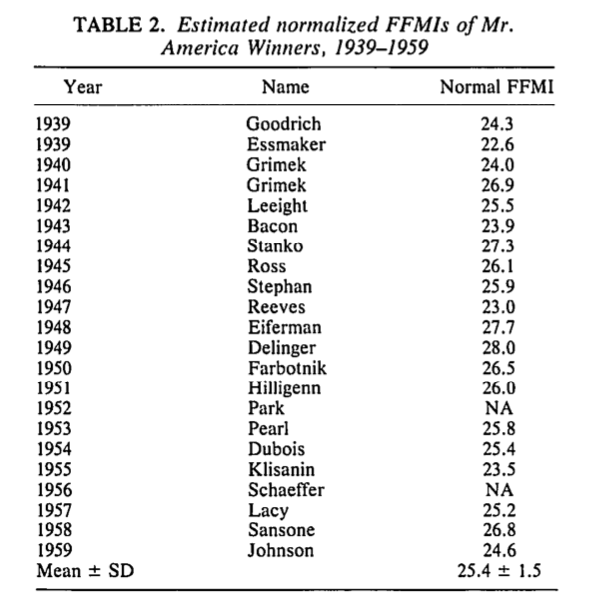On this page is a FFMI Calculator. FFMI, or Fat Free Mass Index, factors in a person's body fat percentage, height, and weight to arrive at a lean mass ratio.
Using that number you can compare your relative muscularity versus benchmarks for large populations of men and women.
Fat Free Mass Index Calculator
What is FFMI?
FFMI, or Fat Free Mass Index is a measurement of your lean mass compared to your height. As opposed to other measures like BMI (body mass index), FFMI takes your muscularity into consideration, and is better suited to athletes and people who work out.
Lean mass isn't just muscularity, however.
Lean mass is everything in your body that isn't fat: muscles, water, undigested food, organs, bones, and so on. Of course, those don't actually change too much for a typical male or female with two exceptions:
- Height: Taller people have larger organs and bones. The basic FFMI formula doesn't fully account for this – in 'Adjusted FFMI' below, the equation normalizes FFMI to a 5'11" male.
- Weight: If you have a higher body fat percentage you can support higher musculature.... up to a point. When you diet without steroids or other artificial help, you'll lose muscle as well as fat. The benchmarks below apply to people with under 10% body fat.
FFMI Formula
To calculate your FFMI, there is a two-step process... assuming you know your body fat percentage (Estimate it from your waist and height measurements. Use the caliper reading from the tool.).
- Calculate your lean weight (in kilograms):
Total Weight * (100% - Body Fat) = Lean Weight (kg) - Divide your Lean Weight by your Height (in meters), squared
FFMI = Lean Weight (kg) / (Height (m) * Height (m))
Normalized FFMI Formula
Since height does affect FFMI and the original 1995 FFMI study from Elena Kouri Ph.D., Harrison Pope Jr. M.D., David Katz M.D., J.D. and Paul Oliva B.A. wanted to better isolate muscle, they also proposed a normalized FFMI formula.
The normalized FFMI formula adjusts the FFMI reading from the above for a 1.8 meter tall (5' 10.87") male:
Normalized FFMI = FFMI + (6.1 * (1.8 - Height (m) ) )
Natural Muscle Limit vs. FFMI
Testosterone, a naturally occurring anabolic steroid was first isolated in 1935. Steroids were used in clinical trials shortly thereafter, and were almost certainly part of German and Allied military experiments during World War II.
I tell you this because steroids almost certainly entered athletics shortly after.
And (of course) steroids are pervasive today. In every sport you can assume that the vast majority of top athletes have some sort of chemical assistance.
I'm not judging. I'm just saying that if you are lifting at the gym and have no interest in steroids, taking hints from muscle magazine covers or athletes on TV isn't realistic.
No matter how perfect your diet, sleep, vitamin regimen, and workout routine – your maximum muscle weight won't be close to the players you see on TV.
How big can you get without steroids?
In Kouri et. al's original paper on FFMI, they theorized that all bodybuilders who won the Mr. America bodybuilding competition after 1960 are suspect.
They took height, weight, and bodyfat percentage estimates for all the winners before 1960 and estimated normalized FFMIs:

Kouri EM1, Pope HG Jr, Katz DL, Oliva P., Fat-free mass index in users and nonusers of anabolic-androgenic steroids.
You'll note that the average Mr. America winner clocked in at around an FFMI of 25 (25.4 to be exact). The "non-steroid" winners ranged between Roland Essmaker's winning 22.6 FFMI in 1939 and Jack Delinger's huge FFMI of 28.0 in 1949.
You probably note the timeline too. If the first steroid was isolated in 1935, potentially everyone above had chemical assistance. It's hard to believe that after World War II – with various armies experimenting – that steroids didn't factor into the contests from 1946-1960.
(Also, what was John Grimek's 1940 off-season like?)
Anyway, let's take the early winners at their word. If Mr. America winners have both superior genetics and come close to perfect with diet and workouts they are a good benchmark for what "might" be possible without steroids.
(Probable) Genetic Max Musculature Based on FFMI
If you are a male and don't take steroids:
- 22-23: Likely attainable
- 24-25: Possible
- 26-28: Theoretically possible (but suspect)
Of course, your own natural build and genetics enter into play. You can always increase your FFMI from your baseline, but a slender male might only make it to 20 or 21 FFMI.

FFMI Benchmarks for Men and Women
Of course, you can go higher than an FFMI of 26-28.
But – other than the absolute top fraction of a percent of athletes (e.g. champion powerlifter Ray Williams) – a higher number will require steroids. Before you choose that path (no judgement!) take a look at what the FFMI scale looks like.
Note that these benchmarks don't account for body fat percentage. If you are dieting but do not have abs yet, expect lower FFMI as you target lower body fat. And if you have a higher body fat percentage note it makes your muscle look softer.
FFMI Benchmarks for Men
- <17: Very low muscle, skinny, "scrawny"
- 17-20: Average male, probably doesn't lift weights
- 20-21: Obviously lifts
- 21-23: Very well-built
- 23-25: Extremely muscular
- 25-28: Superior musculature , "juicy" (and likely not drug-free)
- 28+: With few exceptions, only attainable with steroids, growth hormone, and/or SARMs
FFMI Benchmarks for Women
- <14: Very low muscle
- 14-16: Average female, likely doesn't lift weights
- 16-18: Athletic woman
- 18-19: Very well-built
- 19-21: Extremely muscular
- 20-21+: Hard to obtain without steroids, growth hormone, and/or SARMs
Usefulness of FFMI
FFMI is a useful measure of body composition for both men and women.
It factors in body fat percentage, height, and weight in a smart, normalized way. Importantly, it's an improvement on BMI – which doesn't account for people with above or below average musculature.
FFMI is also useful as a guess of what's possible if you dedicate yourself to drug-free diet and exercise. If you have a slender build (like me), you will likely top out on the lower end of the range. If you are naturally a bit larger, with proper diet, sleep, and exercise you can push 25 or even higher in FFMI.
(For what it's worth, I'm right around an FFMI of 23. I would likely be ~18 without lifting.)
